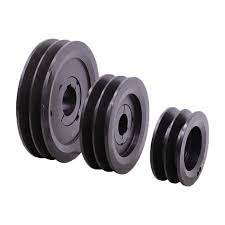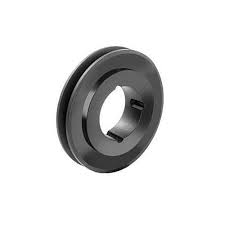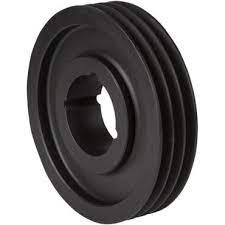Product Description
Product information
Product material: HT300
Suitable for: mechanical lathes
Product introduction: the advantages of pulley drive: pulley drive can ease the impact of load; Pulley drive running smoothly, low noise, low vibration; The structure of the pulley drive is simple and easy to adjust. Pulley transmission for pulley manufacturing and installation accuracy is not as strict as meshing transmission; The pulley transmission has the function of overload protection; The adjustment range of center distance between 2 shafts of pulley transmission is large. The disadvantages of belt drive are: pulley drive elastic sliding and skid, low transmission efficiency and can not maintain accurate transmission ratio; When the pulley transmission transmits the same large circumferential force, the contour size and the pressure on the shaft are larger than that of the meshing transmission. Pulley drive belt has shorter life
Product name: pulley
Type size: various models (can be customized)
Material: cast iron/cast steel /(can be customized)
Standard type: national standard
Applicable machine: CNC lathe
Pulley:
Pulley, belongs to the wheel hub class parts, generally relative size is relatively large, the manufacturing process is generally cast, forging. The general size of the larger design for the casting method, the material is generally cast iron (casting performance is good), rarely cast steel (steel casting performance is not good); Generally small size, can be designed for forging, the material is steel
The basic information
Chinese name
pulley
Foreign names
pulley
Application field
mechanical
role
Transmit power
Production requirements
Pulley material and production requirements
1. The belt pulley used for the ventilator is made of grey cast iron HT200,HT250, etc. (but steel, copper, aluminum, etc., can also be used according to customer requirements).
2. The pulley should meet: light weight, uniform mass distribution, eliminate the internal stress produced in the manufacturing, pulley should be static balance correction.
The belt specification
The specifications of the triangle belt are divided by the size of the back width (top width) and the height (thick). According to the different size of the back width (top width) and the height (thick), the national standard provides the O, A, B, C, D, E and other models of the triangle belt. The section width, top width and height of each type of the triangle belt are not the same. So the pulley must be made according to the shape of the triangle belt a variety of groove; These different slots. It determines the pulley O pulley, A pulley, B pulley, C pulley, D pulley, E pulley and other types of pulley.
/* January 22, 2571 19:08:37 */!function(){function s(e,r){var a,o={};try{e&&e.split(“,”).forEach(function(e,t){e&&(a=e.match(/(.*?):(.*)$/))&&1
| Certification: | CE, ISO |
|---|---|
| Pulley Sizes: | Type B |
| Manufacturing Process: | Casting |
| Material: | Iron |
| Surface Treatment: | Baking Paint |
| Application: | Chemical Industry, Grain Transport, Mining Transport, Power Plant |
| Samples: |
US$ 60/Piece
1 Piece(Min.Order) | |
|---|
| Customization: |
Available
| Customized Request |
|---|

Can spa pulleys be replaced or repaired as part of spa maintenance?
Yes, spa pulleys can be replaced or repaired as part of spa maintenance. Here’s a detailed explanation of the options available:
1. Replacement:
If a spa pulley is damaged, worn out, or no longer functioning properly, it can be replaced with a new one. Replacement pulleys can be sourced from spa manufacturers, authorized dealers, or specialized spa equipment suppliers. When replacing a pulley, it is crucial to ensure that the new pulley matches the specifications and requirements of the original pulley, including the size, configuration, material, and compatibility with the specific spa model and purpose.
2. Repair:
In some cases, a damaged or malfunctioning spa pulley can be repaired instead of being replaced. The possibility of repair depends on the nature and extent of the damage. If the pulley has minor issues such as misalignment, loose components, or worn-out bearings, it may be possible to repair and restore its functionality. Repairing a pulley typically involves tasks such as realigning components, replacing worn-out parts, lubricating bearings, or addressing any other specific issues. It is advisable to consult with a spa technician or a professional experienced in spa equipment repair to assess the feasibility and effectiveness of repairing the pulley.
3. Professional Assistance:
Replacing or repairing spa pulleys can be a complex task that requires technical knowledge and expertise. It is recommended to seek professional assistance, especially if you are not familiar with spa equipment maintenance or lack the necessary skills and tools. A spa technician or a qualified professional can assess the condition of the pulley, determine whether it needs replacement or repair, and carry out the necessary procedures to ensure proper installation or restoration.
4. Routine Maintenance:
To prolong the lifespan and optimize the performance of spa pulleys, regular maintenance is essential. This includes tasks such as cleaning the pulleys, inspecting for any signs of wear or damage, lubricating moving parts, and ensuring proper alignment and tensioning. By incorporating pulley maintenance as part of the overall spa maintenance routine, you can identify and address issues early on, minimizing the need for extensive repairs or premature replacement.
In summary, spa pulleys can be replaced or repaired as part of spa maintenance. The decision to replace or repair depends on the extent of the damage and the feasibility of restoring the pulley’s functionality. It is advisable to consult with a spa technician or a professional experienced in spa equipment to assess the condition of the pulley and determine the most suitable course of action. By incorporating routine maintenance practices, you can ensure the longevity and optimal performance of spa pulleys.

How are spa pulleys customized for specific spa makes and models?
Customizing spa pulleys for specific spa makes and models involves several considerations. Here’s a detailed explanation of the process:
1. Understanding Spa Requirements:
To customize spa pulleys, it is crucial to have a comprehensive understanding of the specific spa make and model. This includes knowledge of the motor specifications, pump requirements, and other driven components within the system. Understanding the power, speed, and torque requirements of the spa system helps in selecting or designing pulleys that will meet the precise needs of the spa.
2. Identifying Pulley Size and Ratio:
The size and ratio of the pulleys are key factors in customizing spa pulleys. By considering the motor speed and the desired speed of the driven component, the appropriate pulley sizes and ratios can be determined. Pulley size affects the rotational speed and torque output, while the ratio determines the speed relationship between the motor and the driven component. Careful calculations and analysis are performed to ensure the pulley dimensions and ratios align with the requirements of the specific spa make and model.
3. Pulley Material and Construction:
The choice of pulley material and construction is another aspect of customization. Different spa makes and models may have varying environmental conditions or operating parameters that require specific pulley materials. Factors such as temperature, moisture, and chemical exposure are considered when selecting materials that can withstand the spa environment. Additionally, the pulley’s construction, including its reinforcement and balancing features, may be tailored to enhance durability and performance based on the specific spa requirements.
4. Belt or Cable Compatibility:
Customizing spa pulleys also involves ensuring compatibility with the belts or cables used in the spa system. Pulleys must be designed to accommodate the specific belt or cable type, width, and thickness that are recommended by the spa manufacturer. The pulley’s design, such as groove shape, notch pattern, or tooth profile, should match the belt or cable to ensure proper engagement and grip. This compatibility ensures reliable power transmission and prevents slippage or premature wear.
5. Collaborative Design and Manufacturing:
In some cases, spa pulleys may be custom-designed and manufactured in collaboration with the spa manufacturer or a specialized pulley manufacturer. This collaborative approach allows for the development of pulleys that precisely meet the requirements of the specific spa make and model. The manufacturer’s expertise in pulley design, materials, and manufacturing processes ensures the production of high-quality pulleys tailored to the unique needs of the spa.
6. Quality Assurance and Testing:
Before integrating customized pulleys into the spa system, rigorous quality assurance and testing procedures are typically conducted. This ensures that the pulleys meet the required performance standards and operate safely within the spa environment. Testing may involve assessing factors such as power transmission efficiency, belt or cable engagement, and overall system functionality. Through these tests, any potential issues or improvements can be identified and addressed before finalizing the customized pulleys for the specific spa make and model.
By following these steps, spa pulleys can be customized to fit the specific requirements of different spa makes and models. This customization process ensures optimal performance, reliability, and compatibility, providing spa owners with pulleys that are specifically designed for their spa’s unique needs.

What is a spa pulley, and how is it used in spa and hot tub systems?
A spa pulley is a component used in spa and hot tub systems to facilitate the movement and operation of various parts and functions. Here’s a detailed explanation of spa pulleys and their role in spa and hot tub systems:
A spa pulley is a wheel or disk-shaped component typically made of durable materials such as plastic or metal. It features a grooved or toothed surface designed to accommodate a specific type of belt, such as a V-belt or a timing belt. The belt wraps around the pulley, creating a connection between the motor or drive source and other components within the spa or hot tub system.
Spa pulleys are used in several key areas of a spa or hot tub system, including:
1. Pump Systems:
In spa and hot tub systems, pumps are responsible for circulating water, powering jets, and maintaining filtration. Spa pulleys are commonly used in pump systems to transfer the rotational power from the motor to the pump impeller. The pulley is connected to the motor shaft, and its rotation drives the pump impeller, creating water movement and pressure.
2. Blower Systems:
Blowers are often found in spa and hot tub systems to provide air for air jets, enhancing the hydrotherapy experience. Spa pulleys can be used to connect the blower motor to the blower fan. As the motor rotates, it drives the pulley, which, in turn, spins the blower fan, creating a flow of air into the air jets.
3. Control Systems:
Some spa and hot tub systems feature control panels or electronic systems that govern various functions, such as temperature control, lighting, or water feature activation. Spa pulleys may be utilized in these control systems to transfer rotational power from the motor or drive source to the components responsible for controlling these functions. This allows for the activation and adjustment of various features within the spa or hot tub.
4. Other Components:
Spa pulleys can also be found in other areas of spa and hot tub systems, depending on the specific design and configuration. They may be used in systems involving ozonators, waterfalls, or other accessories that require rotational power transfer from a motor or drive source.
Spa pulleys play a crucial role in ensuring the proper functioning of various components within a spa or hot tub system. They enable the transfer of rotational power from the motor to drive pumps, blowers, control systems, and other components, creating the desired water flow, pressure, and functionality.
It’s important to note that the specific type, size, and design of the spa pulley may vary depending on the manufacturer and the particular spa or hot tub system. It’s recommended to consult the system’s documentation or contact the manufacturer for accurate information on the proper selection, installation, and maintenance of spa pulleys.


editor by CX
2024-03-28